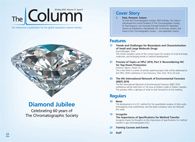Novel Fatty Acid Analysis
Researchers from the USA have developed a simple and derivatization-free gas chromatography (GC) method for the quantitative analysis of oleic acid and related fatty acids.
Photo Credit: duncan1890/ Getty Images

Researchers from the USA have developed a simple and derivatization-free gas chromatography (GC) method for the quantitative analysis of oleic acid and related fatty acids.1
A common pharmaceutical excipient, oleic acid is widely used for long-term stabilization, solid formation bulking, and for the therapeutic enhancement of active ingredients including serving as an emulsion agent in topical pharmaceutical formulations and a solubility enhancer for gastrointestinal tract delivery.
The importance of oleic acids to the pharmaceutical industry has led to a variety of analytical methods being developed with high performance liquid chromatography (HPLC) the most common.1
However, HPLC separation of fatty acids is not perfect. The absence of chromophores or fluorescent functional groups2 means the majority of HPLC methods in the literature require a derivatization process prior to analysis; those without a derivatization process suffer from poor sensitivity.3
Gas chromatography offers an alternative for the analysis of fatty acids and is commonly used. Unfortunately, GC methods suffer from a similar issue to HPLC, requiring a derivatization process because of the high boiling points of fatty acids.4
A laborious, tedious, and time-consuming process, derivatization, while effective, often results in lower accuracy and precision5 - two undeniably unwanted side effects. The aim of this
study was to develop a simple method for oleic acid and related fatty acid analysis, free from a derivatization process, but capable of accurate and robust analysis suitable for use in a quality controlled laboratory.
The method developed used a nitroterephthalic acid modified polyethylene glycol (PEG) capillary GC column as well as a flame ionization detector (FID). The sample preparation procedure was simple and straightforward requiring no derivatization. The method successfully separated 15 fatty acids in a total run time of 20 min. This was validated and proved to be specific, precise, and accurate for the analysis of oleic acid and related fatty acids. - L.B.
References
- H. Zhang et al.,J. Pharm. Anal.5, 223–230 (2015).
- Y. Tsuyama et al., J. Chromatogr. A596, 181–184 (1992).
- H. Guo et al., J. Am. Oil Chem. Soc. 89, 183–187 (2012).
- T.S. Laakso et al., Anal. Chim. Acta.465, 39–62 (2002).
- M. Mizumoto et al., J. Anal. Appl. Pyrolysis87, 163–167 (2011).

HPLC 2025 Preview: Functionalized Monoliths as Selective Sample Preparation Materials
May 16th 2025Analyzing trace compounds from complex samples often requires purification and pre-concentration, and online coupling of solid-phase extraction (SPE) with liquid chromatography (LC) helps minimize analysis time and solvent/sample use. Monoliths with large macropores are ideal for this coupling due to their low back pressure and versatility in various formats.
Quantifying Inorganic Carbon in Soil Using Sulfamic Acid and Gas Chromatography
May 15th 2025Researchers at Andes Ag, Inc. (Alameda, California) established a high-throughput framework for the robust and precise quantification of soil inorganic carbon (SIC) from agricultural soils using gas chromatography (GC).
Analysis of Ultrashort-Chain and Short-Chain (C1 to C4) PFAS in Water Samples (May 2025)
May 15th 2025In this study, an accurate, reliable analytical LC-MS/MS method for PFAS in water was developed to specifically quantify C1 to C4 PFAS in both potable and non-potable sources. A direct injection workflow was implemented to simplify the testing process and to avoid potential contamination originating from poor sample preparation procedures.
Analysis of PFAS in Milk by LC-MS/MS
May 15th 2025Dairy milk is one commodity that can be impacted by environmental contaminants, such as PFAS, so it is important to implement extensive, robust, and accurate testing. In this work, a sensitive and reliable method was developed for the analysis of PFAS in milk by LC-MS/MS at levels as low as 0.01 µg/kg.

.png&w=3840&q=75)

.png&w=3840&q=75)



.png&w=3840&q=75)



.png&w=3840&q=75)












